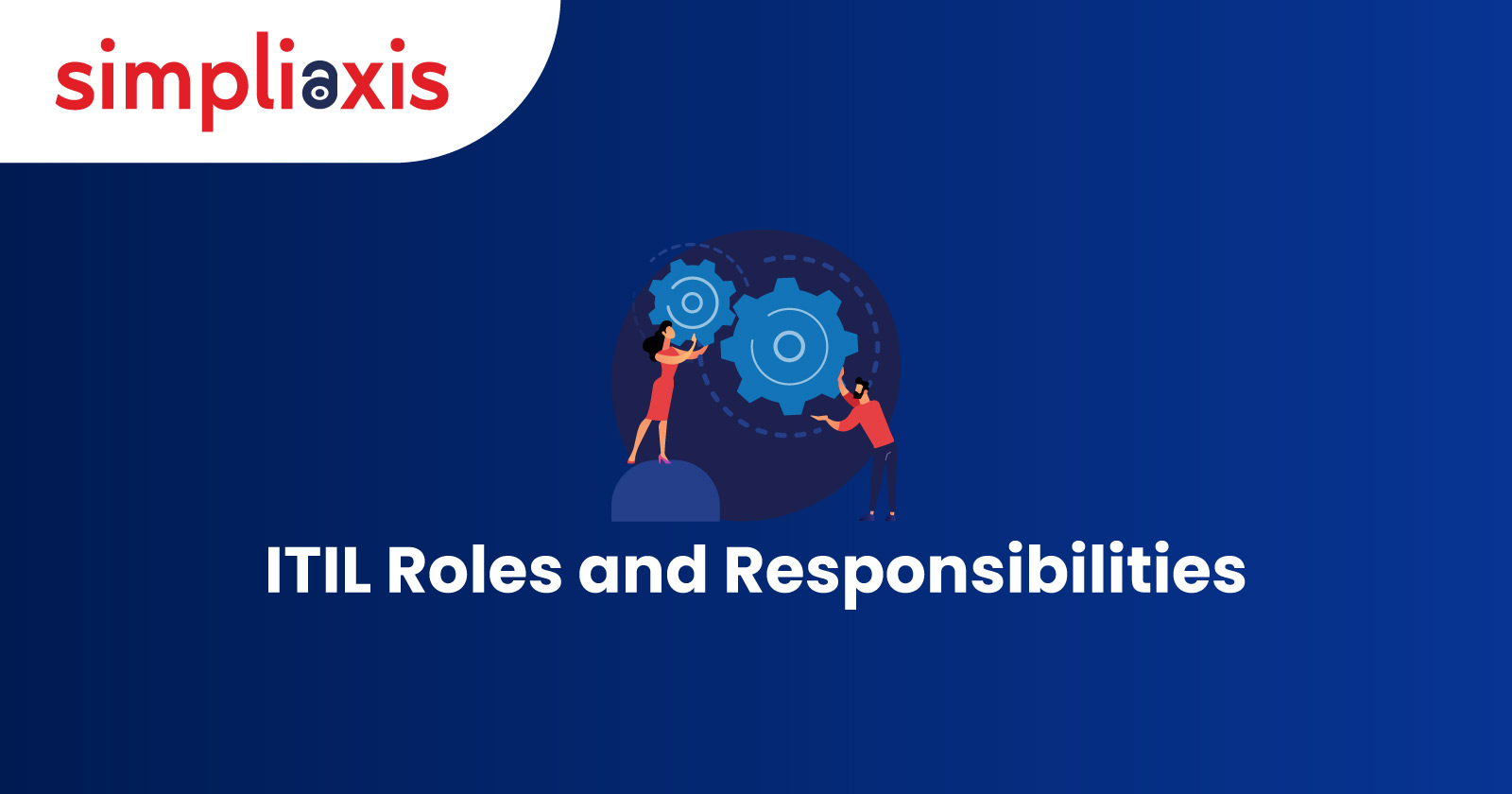The acronym ITIL refers to the Information Technology Infrastructure Library. With the development of IT Service Management, also popularly known as ITSM skills, one of the most vital aspects must include the kinds of jobs. Admittedly, it is apparent that one can't complete anything without the right people.
To offer clarity and assistance, ITIL provides several non-exclusive job sorts that are material across its many ITSM procedures. These are explicit, as opposed to traditional tasks, which become explicit when associated with a specific ITIL process.
ITIL Generic Roles and Responsibilities
Here's Some generic ITIL service roles and their responsibilities:
Process Owner: Process owners ensure that their specific processes operate as intended. They ensure that agreed-upon processes meet their objectives and are executed as documented. Process owners may be responsible for multiple processes. They are also accountable for the structure, sponsorship, and change management of their processes and related metrics. Additional responsibilities include process-related communication, resource provision, improvement activities, periodical process reviews, and process audits. An example role might be "Head of Service Operations."
Process Manager:Process managers collaborate with process owners to determine how process activities will be carried out and are responsible for ensuring their execution. In larger organizations, process managers are typically distinct from process owners. One process might have multiple managers, especially in different locations. For instance, the IT Service Desk Manager manages the incident management process and ensures smooth operation. Additional activities include people management, process management, performance reporting, and process improvement.
Process Practitioner:Process practitioners are responsible for performing the core activities of a process and may also maintain records to demonstrate that these activities have been completed correctly. For example, an IT Service Desk Agent ensures that all necessary information and authorisations are in place for handling an access request and is responsible for documenting and verifying the completion of these activities. Process practitioners work closely with service users, clients, management, and colleagues to ensure process effectiveness and understand their organizational role.
Service Owner:An example role could be "IT Comms Services Manager." Service owners are crucial in ITSM, initiating new IT services, overseeing their production transition, and ensuring ongoing maintenance. They deliver services within agreed-upon levels, maintain customer relationships, and align services with business needs. Service owners may manage multiple services and lead a team of technical specialists. For instance, the IT Comms Services Manager oversees various communication channels to meet business requirements, address issues, and keep services up-to-date. Their responsibilities include managing changes, identifying and implementing improvements, and regular reviews and audits of their services.
List of ITIL Roles and Responsibilities
1. Service Strategy
The primary aim of this ITIL Service Approach is to develop, build, and select a strategy that serves the interests of the customers. This stage lays down and determines the services that the IT organization will provide and also what competencies need to be created, starting with an assessment of customer demands and the market environment. Its ultimate objective is to get the IT department to think and act strategically-
Business Relationship Manager:
The person holding this position is in charge of maintaining strong client relationships, understanding client requirements, and assuring that the service provider can address these demands with an adequate catalogue of services. The person managing this role must work collaboratively with the Service Level Manager.
Demand Manager:
This particular job of the demand manager has been created to carry out the actions in the demand management process. Understanding, forecasting, and manipulating client requirements for services are included in the responsibilities of this role. The person managing this role is expected to work collaboratively with the Capacity Manager to guarantee the capability to fulfil consumer demands.
Service Strategy Manager:
To evaluate the service provider's offers, capabilities, rivals, and present and future market areas to design a customer-serving strategy.
Financial Manager:
This process tracks the service provider's budgeting, accounting, and billing obligations. The Financial Manager oversees an IT service provider's budgeting, accounting, and pricing needs.
Another aspect associated with this ITIL role and responsibilities is that the statements of accounts are distributed to management so that process managers may manage their budgets. Furthermore, the financial manager evaluates and reports on value-for-money analyses of all important operations, projects, and planned spending items.
Service Portfolio Manager:
This process tracks the service portfolio. The manager must ensure that the necessary mix of services exists to achieve the desired business goals while maintaining a reasonable level of investment.
2. Service Design
This list includes all critical roles specified in the ITIL service design module. ITIL Service Design aims to create new IT services. The Service Design stages of ITIL lifecycle cover both the creation of new services and the modification and upgrading of existing ones.
Applications Analyst: The Applications Analyst is an Application Management position that oversees the lifetime of applications. Each significant application usually has an individual or a team to command this role. This function is critical in application-related areas of IT service design, testing, operation, and improvement. It's also responsible for honing the skills needed to run the programs to supply IT services.
Availability Manager: The availability manager defines, analyses, plans, measures, and improves all elements of IT service availability. He ensures that all IT infrastructure, procedures, tools, and responsibilities are appropriate for the agreed-upon availability service level objectives.
Capacity Manager: The person taking up this role is required to ensure that services and infrastructure can meet agreed-upon capacity and performance goals cost-effectively and without excessive time-consuming work. He examines the resources needed to offer the service and makes short, medium, and long-term business strategies.
Service Design Manager: This role is responsible for creating high-quality, secure, and durable designs for new or updated services and for creating and maintaining all design documentation.
Enterprise Architect: The Enterprise Architect (EA) manages the EA, which describes a company's critical components and interrelationships. Specialist EA jobs such as Business Architect, Application Architect, and Information Architect may be introduced in larger businesses.
Information Security Manager: This position is in charge of maintaining the firm's security regarding confidentiality matters. The manager is supposed to ensure integrity and the availability of a business's assets, information, data, and IT services. He is generally involved in an organizational approach to security management that extends beyond the IT service provider and requires document handling, building access, and phone calls for the entire firm.
Compliance Manager: The person handling this job must ensure that policies and procedures are followed and that correct, consistent accounting and other processes are used. This involves making certain that all exterior legal obligations are met.
IT Service Continuity Manager: This individual is responsible for resolving risks that might substantially affect IT services. By lowering the risk to a tolerable level and planning for the recovery of IT services, the person holding this position ensures that the IT service provider will be able to meet the minimum agreed-upon service levels in the case of a disaster.
Risk Manager: This role involves finding, evaluating, and managing risks. This entails determining the value of assets to the company, identifying risks to those assets, and determining each asset's vulnerability to those threats.
Service Catalog Manager: The person holding this role is in charge of keeping the Service Catalog in proper condition, ensuring all of the information included is correct and up to date with all the updates incorporated.
Service Level Manager: The service level manager negotiates and enforces Service Level Agreements. He ensures that the ITSM, Operational Level Agreements (OLAs), and Underlying Contracts are appropriate for the service level objectives that have been agreed upon. The person holding this role also keeps track of service levels and reports on them.
Service Owner: This person is responsible for ensuring that a certain service is delivered within the agreed-upon service requirements. When negotiating OLAs, he usually functions as the Service Level Manager's counterpart.
Supplier Manager: This role requires the person in charge to ensure that all suppliers provide good value for money. He ensures that supplier contracts support the business's needs and that all suppliers fulfill their contractual obligations.
Technical Analyst: Under this job, Technical Management is required to arrange for technical expertise & assistance for IT infrastructure management. There is usually one team of analysts or an individual technical analyst for each significant technological area.
This position is critical in the technical elements of IT service design, testing, operation, and improvement. It's also in charge of fostering the skills needed to run the IT infrastructure.
3. Service Transition
At this stage of the ITIL Service Transition, the prime objective is to create and deliver IT services. This also includes carrying out the changes to services and service management procedures in a coordinated fashion throughout the lifecycle of this particular stage.
Project Manager: The project Manager role involves planning, managing, and scheduling the resources needed to launch significant releases within the projected cost, time, and quality estimates.
Change Manager: The person handling this ITIL role oversees the lifetime of all Changes. His major responsibility is to ensure that good changes may be implemented with little interruption to IT services. Before continuing with any significant/major changes, the Change Manager must obtain approval from the Change Advisory Board (CAB).
Change Advisory Board (CAB): This Board consists of individuals (often key stakeholders) who advise the Change Manager on the evaluation, prioritization, and scheduling of changes. It is often comprised of members from all parts of the IT organization, including the company, the IT Department, and third parties such as suppliers.
Emergency Change Advisory Board (ECAB): This subgroup of the CAB makes high-impact and emergency change decisions. Members of the ECAB are typically chosen dynamically when a meeting is called, and the nature of the concerned emergency/crisis change determines their membership.
Configuration Manager: This position demands the person holding it to preserve accurate information about Configuration Items (CIs) used to provide IT services. He must maintain a logical model containing the IT infrastructure (CIs) components and their relationships.
Release Manager: The Release Manager is in charge of planning and overseeing the deployment of Releases to test and live environments. The major responsibility is maintaining the integrity of the live environment and releasing the proper components.
Test Manager: The Test Manager is in charge of verifying that the distributed releases and the associated services fulfill customer expectations and guaranteeing that the IT operations department can support the new service.
Knowledge Manager: The major responsibility of the person commanding this role is to guarantee that the IT organization can acquire, evaluate, store, and distribute knowledge and information. His main goal is to increase efficiency by eliminating the need to relearn knowledge.
Application Developer: The Application Developer is responsible for developing and coding apps and systems that offer the necessary functionality for IT services. His responsibilities include the creation and maintenance of bespoke applications/software, as well as the customization of goods acquired from software providers.
4. Service Operation
The aim here is to ensure the successful and efficient delivery of IT services by completing and properly addressing the requests from customers and users, properly dealing with service issues, and troubleshooting while performing normal operational duties.
IT Operations Manager: An IT Operations Manager oversees various Service Operation Processes and Functions.
IT Operators: IT Operators are the employees who handle the day-to-day operations of information technology. Their tasks include doing backups and restores, completing planned jobs, installing software, and installing standard data center equipment.
1st Level Support: This team is responsible for registering, categorizing, and prioritizing incoming incidents and promptly reinstating a failing IT service as soon as feasible. If an impromptu solution cannot be given, the problem will be escalated to demand the attention of applicable specialists to the Incident. Furthermore, this team is in charge of processing Service Requests and informing users about the progress of their Incidents at pre-determined intervals.
Second-Level Support: The 2nd-level Support team handles incidents that cannot be handled by the 1st-level Support team immediately. If necessary, it will seek external assistance from software or hardware makers (3rd-level Support). The primary goal of this role is to restore a failing IT service as soon as feasible. If no resolution is discovered, the Incident is transferred to the Problem Management group by the 2nd-level Support.
Incident Manager: The Incident Manager is responsible for properly executing the ITIL Incident Management procedure and the associated reporting. He is the first escalation level for incidents that cannot be resolved within an agreed-upon Service Level.
Major Incident Team: This dynamic team includes technical professionals and IT managers who work together to resolve major incidents. Typically, this team works under the direction of the Incident Manager.
Service Request Fulfillment Groups: Service Request Fulfillment Groups are teams that specialize in completing specific Service Requests. 1st Level Support often handles simpler requests, while more complicated ones are routed to specialist Fulfillment Groups.
Problem Manager: The primary responsibility of the Problem Manager is to manage the lifetime of all problems. He is in charge of preventing Incidents from occurring and minimizing the consequences of Incidents that cannot be avoided. To do this, he also keeps track of known errors and workarounds.
Access Manager: The Access Manager allows authorized users access to a service while prohibiting non-authorized users from accessing it. The Access Manager is primarily responsible for carrying out the organizational policies outlined in Information Security Management.
Service Desk Manager: A separate Service Desk Manager is employed in sure bigger organizations to supervise the Service Desk. Under the guidance of the Incident Manager, they are in charge of handling the service desk.
Technical Analyst: This job requires the manager to provide technical expertise and any assistance necessary for IT infrastructure management. Each significant technological area usually has an individual or a team to command this role. A Technical Analyst is responsible for the technical elements of creating, testing, running, and upgrading IT systems. This person is also responsible for creating the skills required to run the IT infrastructure.
Facilities Manager: The concerned person manages the upkeep of the facilities, which refers to the physical environment in which the infrastructural aspects of the IT setup are housed. This comprises electricity, cooling, fire safety, building access control, and environmental monitoring.
Application Analyst: This role pertains to the management of applications. In this job, the person is in charge of overseeing applications across their lifespan. For each significant application, one position is usually required. An application analyst is responsible for the application-related parts of creating, managing, testing, and enhancing the services. This function is, moreover, in charge of skill-building, which is required to run the programs used to provide IT services.
5. Continual Service Improvement:
The Continual Service Improvement approach employs quality management methodologies to learn from past achievements and mistakes.
CSI Manager: This role stands for Continuous Service Improvement, and the person handling this role is in charge of constantly managing and improving ITSM procedures and IT services. This function is responsible for continuously measuring the service provider's performance, identifying opportunity areas, and designing enhancements accordingly to increase efficiency and effectiveness in terms of costs.
Process Owner: This person is responsible for ensuring a process is suitable for its purpose. Process Owners are responsible for the design, sponsorship, ongoing upgrades, and associated KPIs. Larger businesses often treat process owners differently from process managers and employ different employees for positions accordingly. In this case, the Process Manager is often in charge of the operational administration of a process.
Process Architect: This person is in charge of keeping the Process Architecture up to date (a part of the Enterprise Architecture), coordinating all process modifications, and ensuring that all processes function in unison. Process Architects also assist all parties managing and improving processes, particularly Process Owners. This function is sometimes combined with the role of EA in some businesses.
6. ITIL roles outside of the IT organisation
Customers and Service Users constitute two other ITIL roles and responsibilities outside an IT organization. An IT service provider's customer determines and decides on service-level objectives. Additionally, a service user is a person who utilizes one or more IT services daily. There is an important distinction between service users and customers. While service users use IT services directly, not all customers do so.
Also, Check:
Conclusion
ITIL Roles and Responsibilities are the cornerstone of efficient and effective operations in the dynamic world of IT service management. By allocating distinct roles to professionals, organizations can streamline their processes, enhance accountability, and ultimately ensure the alignment of IT services with the ever-evolving business needs.
At Simpliaxis, we understand the significance of a well-defined ITIL framework. Our solutions complement your IT service management efforts, making your organization's journey smoother and more efficient. With the right tools and a clear understanding of ITIL Roles and Responsibilities, you can empower your team to deliver exceptional IT services that drive business success; simplify your learning experience with our flexible online courses, allowing you to learn at your own pace and prepare for ITIL Certification. Don't hesitate any longer – Begin your journey towards ITIL Certification with Simpliaxis today!













 +1-361-998-9988
+1-361-998-9988


